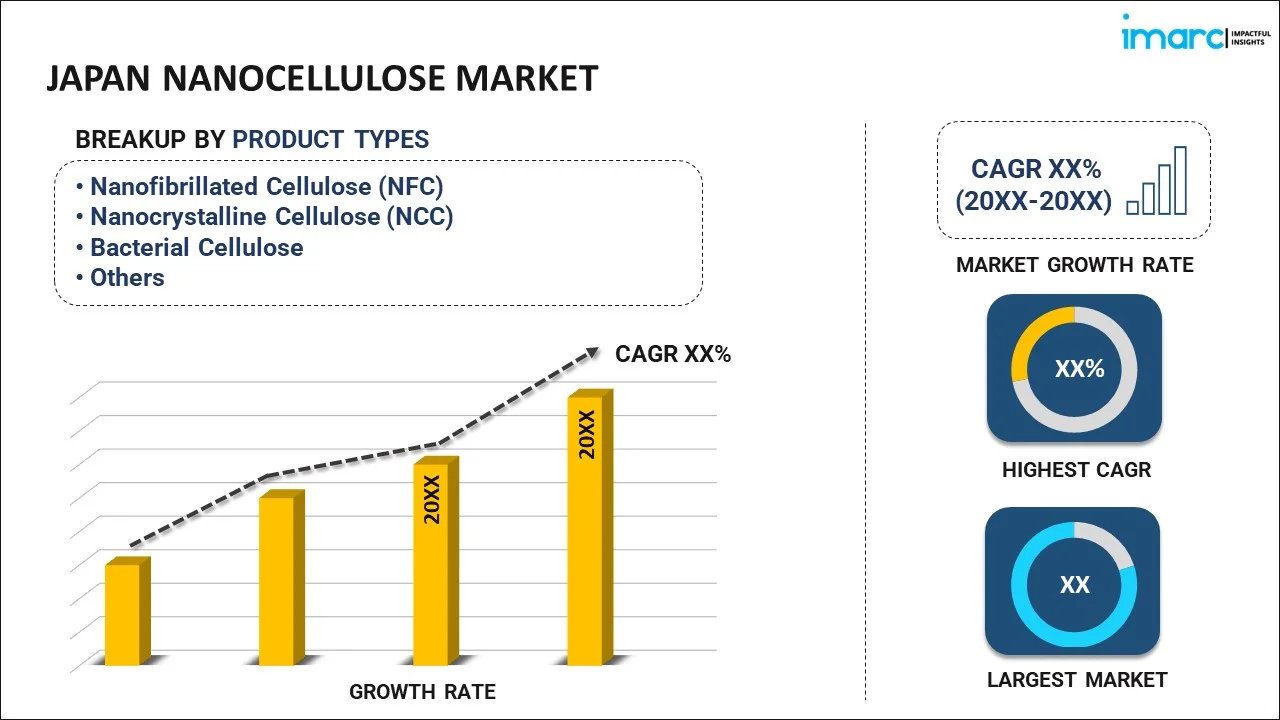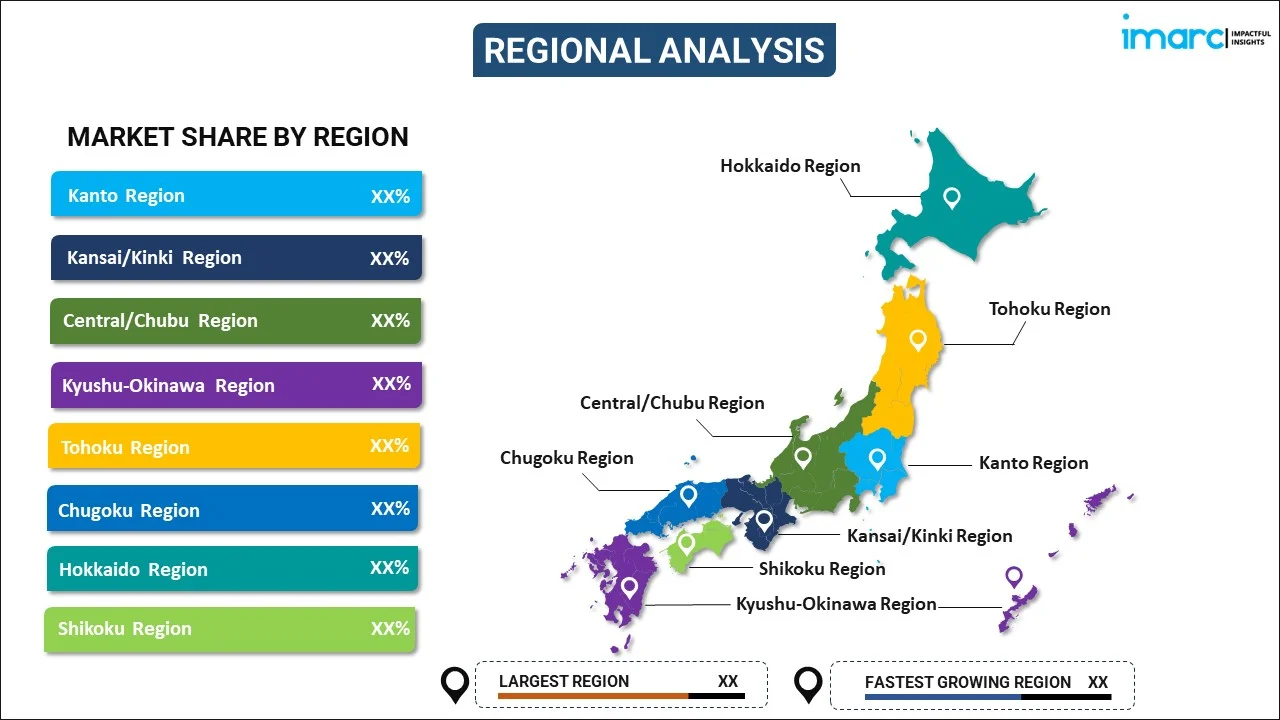
Japan Nanocellulose Market Report by Product Type (Nanofibrillated Cellulose (NFC), Nanocrystalline Cellulose (NCC), Bacterial Cellulose, Microfibrillated Cellulose (MFC), and Others), Application (Pulp and Paperboard, Composites, Pharmaceuticals and Biomedical, Electronics, Food and Beverages, and Others), and Region 2025-2033
Market Overview:
Japan nanocellulose market size reached USD 31.6 Million in 2024. Looking forward, IMARC Group expects the market to reach USD 144.6 Million by 2033, exhibiting a growth rate (CAGR) of 17.02% during 2025-2033. The increasing demand for environmentally friendly and sustainable products, which are pushing manufacturers to incorporate nanocellulose into their offerings, is driving the market.
|
Report Attribute
|
Key Statistics
|
|---|---|
|
Base Year
|
2024 |
|
Forecast Years
|
2025-2033
|
|
Historical Years
|
2019-2024
|
| Market Size in 2024 | USD 31.6 Million |
| Market Forecast in 2033 | USD 144.6 Million |
| Market Growth Rate (2025-2033) | 17.02% |
Nanocellulose is a remarkable material derived from cellulose, a natural polymer found in the plant cell walls. It is composed of tiny, nanometer-sized cellulose fibers and is known for its exceptional mechanical strength, high surface area, and biodegradability. Nanocellulose can be obtained through various methods, such as mechanical treatment, chemical processing, or enzymatic hydrolysis, which breaks down cellulose into its nanoscale components. This versatile nanomaterial has gained significant attention in various industries, including food packaging, biomedical applications, and nanocomposites, for its unique properties. It can enhance the mechanical and barrier properties of materials while being environmentally friendly. In medicine, nanocellulose has potential uses in wound dressings, drug delivery, and tissue engineering due to its biocompatibility. Its applications also extend to the development of sustainable and lightweight materials in the automotive and construction sectors. Overall, nanocellulose holds promise as a sustainable and versatile material with a variety of applications, offering both economic and environmental benefits.
Japan Nanocellulose Market Trends:
The nanocellulose market in Japan is experiencing substantial growth due to several key drivers. Firstly, the increasing awareness and emphasis on sustainable and eco-friendly materials have propelled the demand for nanocellulose. Furthermore, the unique properties of nanocellulose, such as its exceptional strength, lightweight nature, and biodegradability, make it an attractive choice in various industries. Moreover, advancements in nanotechnology and nanocellulose production techniques have significantly lowered manufacturing costs, making it a more cost-effective alternative for industries looking to replace conventional materials. In addition to this, the escalating demand for nanocellulose in applications like packaging materials, composites, and biomedical products is contributing to its market expansion. Furthermore, governments and regulatory bodies in Japan are promoting the use of nanocellulose through policies and regulations that encourage sustainable practices. These regulatory measures are expected to drive the nanocellulose market growth by incentivizing businesses to adopt nanocellulose-based solutions.
Japan Nanocellulose Market Segmentation:
IMARC Group provides an analysis of the key trends in each segment of the market, along with forecasts at the country level for 2025-2033. Our report has categorized the market based on product type and application.
Product Type Insights:

- Nanofibrillated Cellulose (NFC)
- Nanocrystalline Cellulose (NCC)
- Bacterial Cellulose
- Microfibrillated Cellulose (MFC)
- Others
The report has provided a detailed breakup and analysis of the market based on the product type. This includes nanofibrillated cellulose (NFC), nanocrystalline cellulose (NCC), bacterial cellulose, microfibrillated cellulose (MFC), and others.
Application Insights:
- Pulp and Paperboard
- Composites
- Pharmaceuticals and Biomedical
- Electronics
- Food and Beverages
- Others
A detailed breakup and analysis of the market based on the application have also been provided in the report. This includes pulp and paperboard, composites, pharmaceuticals and biomedical, electronics, food and beverages, and others.
Regional Insights:

- Kanto Region
- Kansai/Kinki Region
- Central/ Chubu Region
- Kyushu-Okinawa Region
- Tohoku Region
- Chugoku Region
- Hokkaido Region
- Shikoku Region
The report has also provided a comprehensive analysis of all the major regional markets, which include Kanto Region, Kansai/Kinki Region, Central/ Chubu Region, Kyushu-Okinawa Region, Tohoku Region, Chugoku Region, Hokkaido Region, and Shikoku Region.
Competitive Landscape:
The market research report has also provided a comprehensive analysis of the competitive landscape. Competitive analysis such as market structure, key player positioning, top winning strategies, competitive dashboard, and company evaluation quadrant has been covered in the report. Also, detailed profiles of all major companies have been provided.
Japan Nanocellulose Market Report Coverage:
| Report Features | Details |
|---|---|
| Base Year of the Analysis | 2024 |
| Historical Period | 2019-2024 |
| Forecast Period | 2025-2033 |
| Units | Million USD |
| Scope of the Report | Exploration of Historical and Forecast Trends, Industry Catalysts and Challenges, Segment-Wise Historical and Predictive Market Assessment:
|
| Product Types Covered | Nanofibrillated Cellulose (NFC), Nanocrystalline Cellulose (NCC), Bacterial Cellulose, Microfibrillated Cellulose (MFC), Others |
| Applications Covered | Pulp and Paperboard, Composites, Pharmaceuticals and Biomedical, Electronics, Food and Beverages, Others |
| Regions Covered | Kanto Region, Kansai/Kinki Region, Central/ Chubu Region, Kyushu-Okinawa Region, Tohoku Region, Chugoku Region, Hokkaido Region, Shikoku Region |
| Customization Scope | 10% Free Customization |
| Post-Sale Analyst Support | 10-12 Weeks |
| Delivery Format | PDF and Excel through Email (We can also provide the editable version of the report in PPT/Word format on special request) |
Key Questions Answered in This Report:
- How has the Japan nanocellulose market performed so far and how will it perform in the coming years?
- What has been the impact of COVID-19 on the Japan nanocellulose market?
- What is the breakup of the Japan nanocellulose market on the basis of product type?
- What is the breakup of the Japan nanocellulose market on the basis of application?
- What are the various stages in the value chain of the Japan nanocellulose market?
- What are the key driving factors and challenges in the Japan nanocellulose?
- What is the structure of the Japan nanocellulose market and who are the key players?
- What is the degree of competition in the Japan nanocellulose market?
Key Benefits for Stakeholders:
- IMARC’s industry report offers a comprehensive quantitative analysis of various market segments, historical and current market trends, market forecasts, and dynamics of the Japan nanocellulose market from 2019-2033.
- The research report provides the latest information on the market drivers, challenges, and opportunities in the Japan nanocellulose market.
- Porter's five forces analysis assist stakeholders in assessing the impact of new entrants, competitive rivalry, supplier power, buyer power, and the threat of substitution. It helps stakeholders to analyze the level of competition within the Japan nanocellulose industry and its attractiveness.
- Competitive landscape allows stakeholders to understand their competitive environment and provides an insight into the current positions of key players in the market.
Need more help?
- Speak to our experienced analysts for insights on the current market scenarios.
- Include additional segments and countries to customize the report as per your requirement.
- Gain an unparalleled competitive advantage in your domain by understanding how to utilize the report and positively impacting your operations and revenue.
- For further assistance, please connect with our analysts.
 Inquire Before Buying
Inquire Before Buying
 Speak to an Analyst
Speak to an Analyst
 Request Brochure
Request Brochure
 Request Customization
Request Customization




.webp)




.webp)












